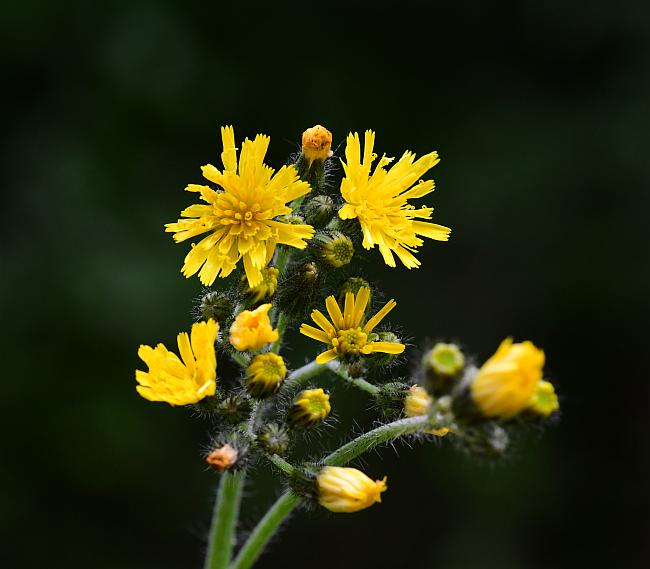Hieracium caespitosum Dumort.
Yellow King-Devil

Introduced
CC = *
CW = 5
MOC = 1
© SRTurner
Hieracium caespitosum Dumort.Yellow King-Devil | |
 |
Introduced CC = * CW = 5 MOC = 1 |
© SRTurner |
|
Family - Asteraceae/Cichorieae Habit - Perennial forb with rhizomes and usually stolons, colonial, with milky sap.
Stems - Erect, to 1 m, solitary to several, unbranched below the inflorescence, moderately to densely pubescent toward the base with light orangish brown, spreading to loosely ascending hairs 2-4 mm long having a bulbous or slightly expanded base, these becoming sparse or absent toward the tip, also inconspicuously pubescent with minute, branched hairs, especially toward the tip, also with moderate to dense, dark-colored, gland-tipped hairs toward the tip.
Leaves - Basal and alternate, simple. Basal leaves persistent at flowering, sessile or with a short, indistinct, winged petiole, the blade 4-25 cm long, narrowly oblanceolate, sharply pointed at the tip, the surfaces and margins pubescent with moderate to dense, spreading, bulbous-based hairs (these often relatively dark-colored) and sparse to moderate, minute, branched hairs. Stem leaves only 1 or 2 toward the stem base, similar to but shorter than the basal leaves, mostly sessile, narrowly oblanceolate to linear, the base not clasping the stem.
Inflorescences - Short, spreading panicles, sometimes reduced to a loose or dense terminal cluster of few to several heads.
Heads - Ligulate. Involucre 6-9 mm long, the inner series of bracts narrowly oblong-elliptic, pubescent with spreading, dark-colored, gland-tipped hairs and usually also inconspicuous, minute, cobwebby, branched hairs, the outer series variable and grading into the inner series, some of the bracts more than 1/2 as long as those of the inner series. Florets 25-70 per head.
Florets - Corollas 8-14 mm long, bright yellow. Pappus bristles 4-6 mm long, white.
Fruits - Achenes 1.5-2.0 mm long, more or less cylindrical, not tapered at the tip. Flowering - June - September. Habitat - Open grassy areas. Origin - Native to Europe. Lookalikes - Other species of Hieracium. More broadly, numerous other species within the Cichorieae tribe (e.g. species of Crepis, Hypochaeris, Leontodon, and others). Other info. - This plant is rare in Missouri, thus far reported (in 1993) from only a single location at or near Shaw Nature Reserve in Franklin County. The Missouri occurrence is far disjunct from other populations, and its history is unknown. The plant is more common in the northeastern U.S., and also in the Northwest, where it is considered a noxious weed. It is distinguished from other species of Hieracium by its white pappus bristles (other Missouri species have tan to brown pappus). Another differentiating factor is its colonial habit, resulting from its production of stolons and rhizomes. The dark colored hairs on the involucre and upper stem, and the relatively few and basally disposed stem leaves, are also characteristic. The plant is tolerant of drought and poor, compacted soils. Photographs taken at Shaw Nature Reserve, Franklin County, MO, 5-31-2021 (SRTurner). |